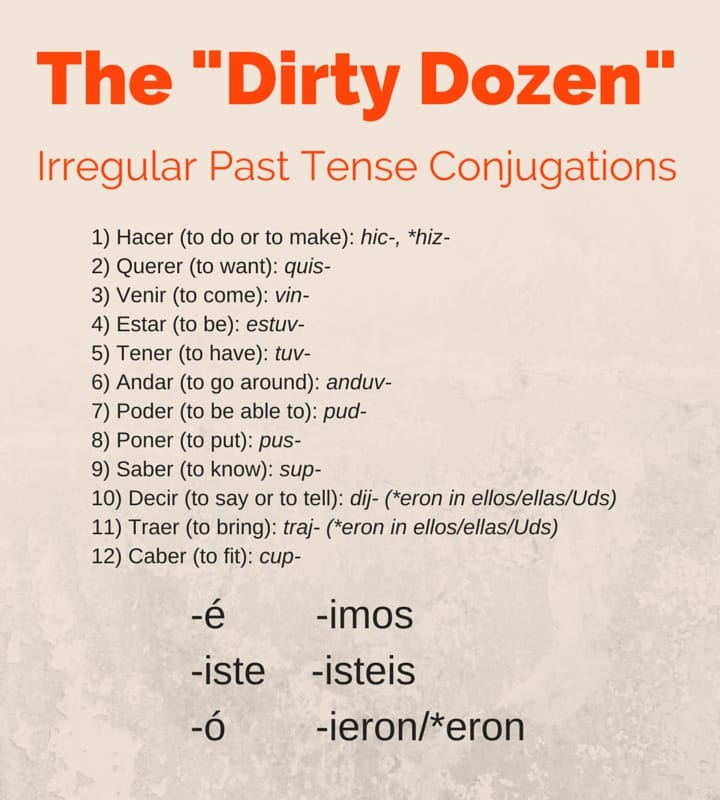
Online Spanish classes are also a great way to work on your skills and make new friends. Outside of total immersion in a Spanish-speaking country, personalized lessons are the best way to get the conversational practice you need to become fluent. While resources such as this one are important for getting down the nuts and bolts of Spanish, working with a Spanish tutor is a sure-fire way to maximize your potential with the language. With both present and past tense verb conjugations under your belt, the future tense will be no problem! You can return to this guide whenever you need a refresher on Spanish past tense conjugations and preterite endings.
#VER PRETERITE HOW TO#
Now that you know how to conjugate Spanish past tense verbs, you’re one step closer to becoming fluent in Spanish.

In English, we tend not to care about these, but learning Spanish past tense conjugation can be more challenging if you don’t pay attention to the details. Below are the 12 verbs, also known as “the dirty dozen.”įinal Spanish Past Tense Conjugation Tipsįinally, don’t forget the accent marks! Accent marks, also known as tildes in Spanish, are necessary to distinguish between two words with the same letters. Fortunately, their main endings are similar to what we’ve already learned in this post: – é, – iste, -ó, – imos, – isteis, – ieron/*eron. Yes, that means that you’ll need to commit each irregular verb conjugation to memory. There are 12 core verbs in Spanish that have irregular past tense conjugations in the preterite tense. Ready for some Spanish past tense conjugation practice? Fill out the following Spanish conjugation chart past tense : SEE ALSO: 75 Most Helpful Spanish Cognates How to Conjugate -IR Verbs in the Spanish PreteriteĬonjugating -ir verbs shares the same rules as conjugating -er verbs. See the following chart as an example. If you are referring to ellos or ‘they,’ use the ending – ieron, to form comieron.To refer to nosotros or ‘we,’ use the ending – imos, to form comimos.If you are referring to él or ella or ‘he’ or ‘she,’ use the ending – ió, to form comió.When you are referring to Tú or ‘you,’ use the ending – iste, to form comiste.If you are referring to Yo or ‘I,’ use the ending – í, (instead of é) to form comí.Now let’s use comer (to eat), as an example. SEE ALSO: 46 Spanish Adjectives to Describe All Your Friends Conjugating -ER Verbs in the Spanish Preterite If you are referring to ellos or ‘they,’ use the ending – aron, to form miraron.(This is the same as present tense conjugation!) To refer to nosotros or ‘we,’ use the ending – amos to form miramos.If you are referring to él or ella or ‘he’ or ‘she,’ use the ending – ó to form miró.When you are referring to Tú or ‘you,’ use the ending – aste, to form miraste.If you are referring to Yo or ‘I,’ add the letter é to end the conjugated verb, forming miré.Here is an example using the Spanish verb mirar (to watch). Keep reading to learn how to change a verb into its past tense form by using preterite endings. The Spanish preterite tense is a way to express the past, and it breaks down verbs into five different endings. How to Conjugate Past Tense in Spanishīefore we dive in, it’s important to note that there are two types of the Spanish past tense conjugation : the preterite and the imperfect. Here, we’ll start with Spanish preterite conjugations and review the imperfect in a future post. This Spanish verb tense can also be used to discuss past events that took place in a sequence, such as when you are listing various items that occurred in the past. Usually, it is meant to discuss specific beginnings and ends as well as things that took place on specific dates or days or at specific times. The preterite tense is used to talk about actions that were completed in the past. When is Preterite Spanish Past Tense Conjugation Necessary? This involves learning Spanish preterite endings, so that you aren’t restricted to only describing actions that are happening in the here-and-now. In this post, we’re going to take your verb conjugation skills to a higher level. Trying to describe only what’s happening in the immediate present, without being able to explain what happened even five seconds ago, is nearly impossible! This reveals how important it is to learn Spanish past tense conjugations. If you’ve learned the basics of verb conjugation in the present tense, you’ve probably realized how limited you are without knowing the past tense versions of the verbs.


 0 kommentar(er)
0 kommentar(er)
